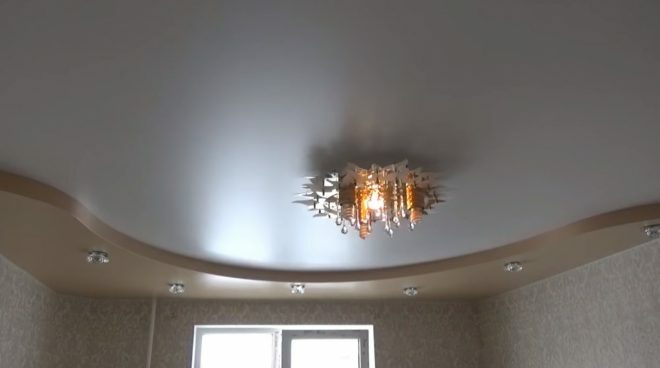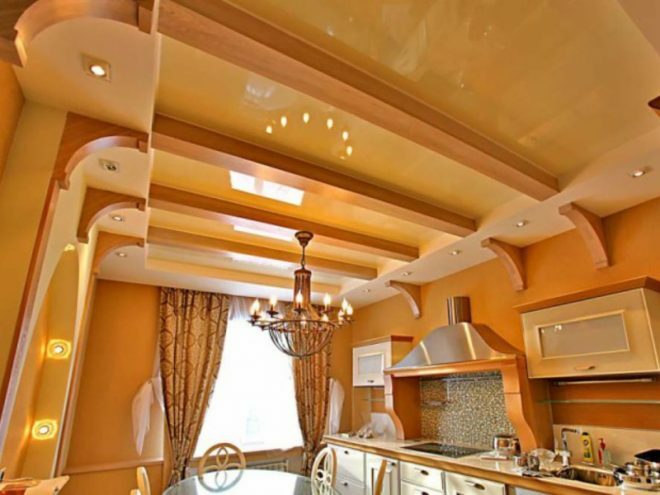Pasting wallpaper is not a complicated process, but provided that the canvases are glued to the walls. When it is required to arrange the ceiling in this way, the task becomes daunting for many. Correct pasting of the ceiling surface is a complex technological process. Making it on your own alone is even more difficult. It is important to go through all the stages of registration: preparation of the plane, marking and cutting, as well as direct gluing. Today I will tell you how to do it competently and without the help of finishers.
@ houzz.com
The content of the article
-
How to glue the wallpaper on the ceiling yourself?
- Preparatory stage
- Marking and cutting of material
- Sticking canvases
- How to glue wallpaper to the ceiling for one person?
- Types of wallpaper suitable for pasting the ceiling
How to glue the wallpaper on the ceiling yourself?
Thanks to their eco-friendly composition, most canvases are perfect for finishing the ceiling in a bedroom or children's room. In these rooms, it is important to monitor the quality of the materials used: they should not harm the body.
Wallpaper is glued to different surfaces - drywall, concrete, plaster, plywood or OSB. The main thing is to comply with the technology.
Preparatory stage
The preparation of the rough ceiling is an important stage that should be given close attention. Remove furniture from the room or cover with protective film, remove paintings and other decorations from the walls, dismantle lighting fixtures, and protect the wires with electrical tape.
I also advise you to turn off the air conditioner or split system in advance and close the windows tightly. This will create a favorable indoor climate for gluing.
Next, we do the following:
- We remove the whitewash. The top layer with a spatula, then the rough plane is washed with a solution of water with the addition of soda.
- Align the surface. With minimal defects, putty is enough, and average-sized irregularities are removed with a layer of plaster. If major alignment is required, plasterboard and suspensions are purchased, making a structure from gypsum plasterboard sheets.
- We ground the ceiling. This will provide maximum adhesion - adhesion to the wallpaper when pasting. The product is applied with a roller or soft brush.
In some places, puttying will be required. The plane must be perfectly flat.
@ repaireasily.ru
Marking and cutting of material
The canvases are glued perpendicular to the window openings. Otherwise, the natural light pouring from the windows will ugly highlight all the joints. For marking from the side wall, measure a segment equal to the width of the roll. From the opposite side, repeat the action, and then connect the resulting points into one line.
The entire ceiling will have to be marked in accordance with the parameters of the selected wallpaper. Do not forget about a slight allowance on both sides of the blade. Next, we proceed to cutting.
The wallpaper is laid out on a flat surface and the required amount is measured for one cut. Separate the resulting piece with a sharp knife or scissors. Do not forget about the pattern: if joining is required, take this into account when cutting. After cutting, number and fold neatly onto a clean surface.
@ bobvila.com
Sticking canvases
A sufficient amount of glue is diluted before gluing the wallpaper. By its structure, it should resemble thick sour cream without lumps. Follow the instructions, as different types of glue are prepared using our own technologies. Some are ready to apply immediately after preparation, while others take time to get the desired consistency.
After making sure that the glue is ready, proceed to gluing:
- We moisten the roller in an adhesive composition and grease the piece of wallpaper as thoroughly as possible, leave it for 10-15 minutes, during which the paper is soaked.
- During this time, we apply glue to the part of the ceiling where the first cut will be glued.
- The sheet is unfolded, applied with the edge to the plane and gently straightened with light strokes on the ceiling.
- Using a rubber spatula or a soft roller, we expel excess air, acting from the center to the edges of the canvas.
- In the corners and joints with the wall, the wallpaper is pressed tightly to the rough plane and the excess is cut off with a sharp knife.
To install the lighting, an incision is made crosswise. After that, wires are threaded into the hole and the edges of the wallpaper are pressed tightly to the surface.
Each sheet is glued quickly so that the glue base does not have time to dry out. Otherwise, the adhesion to the plane will be insufficient. After completing the work, leave the room closed until completely dry.
@ wayfair.com
How to glue wallpaper to the ceiling for one person?
It is quite difficult to do this on your own and alone. In this case, I advise you to choose wallpaper on a non-woven basis. They do not require the application of glue to the canvases, only to the rough ceiling.
We'll have to miss the entire plane and, taking the first segment, carefully glue it. At the same time, it is important work quickly with a roller or trowelso that the wallpaper runs smoothly and without air bubbles.
It is problematic to glue paper sheets, since they quickly disperse and form irregularities, and also require careful application of the adhesive base to the material and the rough surface.
@ youtube.com
Types of wallpaper suitable for pasting the ceiling
Almost any kind of modern materials will do. For a budget finish, choose non-woven or vinyl: they look great and hide small defects.
Their only drawback is low vapor permeability. To avoid unpleasant consequences in the form of mold and mildew formation, I advise you to treat the rough ceiling with antifungal mixtures and let them dry well.
Glass fiber is a stylish material that is allowed to be coated with acrylic paints to your liking. They have a complex texture and are completely environmentally friendly. A good option for a bedroom or children's room.
@ thehandyman.ru
Liquid wallpaper resembles decorative plaster. They are beautiful, elastic and environmentally friendly, they can be easily attached to the ceiling, but they do not have sufficient moisture resistance. Such a finish will not work for the kitchen.
Paper and non-woven wallpaper is the most common material for gluing to the ceiling. They are mounted with your own hands or by the forces of the repair company specialists. The appearance is attractive, increased environmental friendliness and safety for the tenants of the apartment.
Subscribe to our Social Networks


